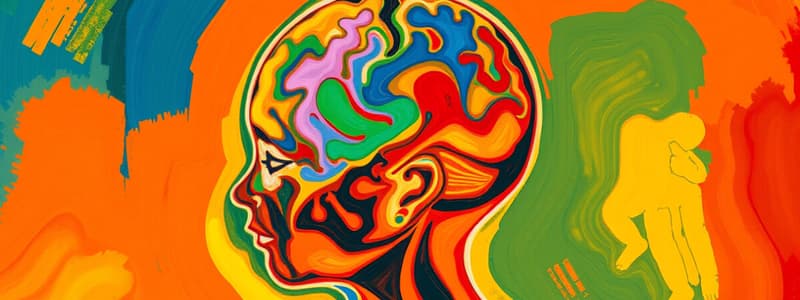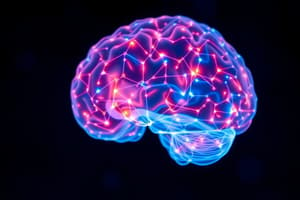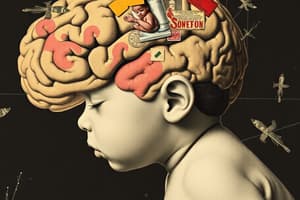Podcast
Questions and Answers
What method do scientists currently find exciting for exploring the mental life of babies?
What method do scientists currently find exciting for exploring the mental life of babies?
- Interviews with parents
- Observation of behavior
- Neuroscientific methods with brain scanning (correct)
- Standardized testing
Babies can communicate their thoughts verbally.
Babies can communicate their thoughts verbally.
False (B)
What can babies do to help researchers understand their preferences?
What can babies do to help researchers understand their preferences?
Suck on a pacifier and control their eye movements
Babies prefer to listen to their mother's voice over a ______ voice.
Babies prefer to listen to their mother's voice over a ______ voice.
Match the following methods of studying babies with their descriptions:
Match the following methods of studying babies with their descriptions:
What preference do babies born to English-speaking parents show?
What preference do babies born to English-speaking parents show?
The predominant method used to study babies involves monitoring their sucking behavior.
The predominant method used to study babies involves monitoring their sucking behavior.
What does monitoring where a baby looks help researchers discover?
What does monitoring where a baby looks help researchers discover?
At what age do children begin to understand that others can have thoughts different from their own?
At what age do children begin to understand that others can have thoughts different from their own?
Children under the age of five understand that others can have false beliefs.
Children under the age of five understand that others can have false beliefs.
What classic task is used to illustrate children's understanding of false beliefs?
What classic task is used to illustrate children's understanding of false beliefs?
Children learn that people's thoughts are __________ and may not reflect reality.
Children learn that people's thoughts are __________ and may not reflect reality.
Match the characters with their actions in the Sally & Anne test:
Match the characters with their actions in the Sally & Anne test:
What will an adult predict Sally will do when she returns?
What will an adult predict Sally will do when she returns?
Understanding that others can have private thoughts is essential for social interactions.
Understanding that others can have private thoughts is essential for social interactions.
In the Sally & Anne test, who moves the marble from the basket to the box?
In the Sally & Anne test, who moves the marble from the basket to the box?
At what age did researchers find babies demonstrating a rudimentary sense of numbers?
At what age did researchers find babies demonstrating a rudimentary sense of numbers?
Babies are known to prefer shapes that resemble faces over those that do not.
Babies are known to prefer shapes that resemble faces over those that do not.
What term do psychologists use to describe becoming bored after looking at something for a while?
What term do psychologists use to describe becoming bored after looking at something for a while?
Babies lack the ability to distinguish between two and three objects.
Babies lack the ability to distinguish between two and three objects.
Who are the two scientists behind the morality play experiments with babies?
Who are the two scientists behind the morality play experiments with babies?
A baby preferred the puppet that showed __________ behavior in the experiment.
A baby preferred the puppet that showed __________ behavior in the experiment.
Why would a baby stare longer at an unexpected event, such as a hat floating?
Why would a baby stare longer at an unexpected event, such as a hat floating?
Babies are shown a situation where they expect _____ to stop a screen from falling.
Babies are shown a situation where they expect _____ to stop a screen from falling.
Match the following age groups with their ability to deceive in the sticker experiment:
Match the following age groups with their ability to deceive in the sticker experiment:
What were researchers attempting to find out with their morality play?
What were researchers attempting to find out with their morality play?
Match the following concepts with their descriptions:
Match the following concepts with their descriptions:
What does the research by Karen Wynn about babies suggest regarding numerical skills?
What does the research by Karen Wynn about babies suggest regarding numerical skills?
Older children demonstrate the same understanding of social interactions as adults.
Older children demonstrate the same understanding of social interactions as adults.
What behavior did the puppet exhibit when it took the ball and ran away?
What behavior did the puppet exhibit when it took the ball and ran away?
Babies do not reason in a manner similar to adults.
Babies do not reason in a manner similar to adults.
Babies are shown to orient toward shapes that resemble __________.
Babies are shown to orient toward shapes that resemble __________.
What can prolonged attention to a certain color, followed by a different color indicate?
What can prolonged attention to a certain color, followed by a different color indicate?
In the experiment with the disappearing toy, the baby is surprised when the screen comes down and shows _____ toys instead of the expected amount.
In the experiment with the disappearing toy, the baby is surprised when the screen comes down and shows _____ toys instead of the expected amount.
Match the following characters in the morality play with their actions:
Match the following characters in the morality play with their actions:
What did Mary and Paul aim to find out about babies?
What did Mary and Paul aim to find out about babies?
Match the baby's reaction to the corresponding scenario:
Match the baby's reaction to the corresponding scenario:
What kind of knowledge do studies reveal babies possess by their first birthday?
What kind of knowledge do studies reveal babies possess by their first birthday?
The experimenter was aware of which puppet was considered the 'good guy'.
The experimenter was aware of which puppet was considered the 'good guy'.
What does the behavior of the monkey in Jacob's sticker experiment symbolize?
What does the behavior of the monkey in Jacob's sticker experiment symbolize?
According to Piaget, babies do not understand that objects continue to exist when out of sight.
According to Piaget, babies do not understand that objects continue to exist when out of sight.
Jacob's inability to deceive the monkey indicates his __________ understanding of social exchanges.
Jacob's inability to deceive the monkey indicates his __________ understanding of social exchanges.
What should happen in a scenario where a block is removed through a trap door, according to babies’ understanding?
What should happen in a scenario where a block is removed through a trap door, according to babies’ understanding?
The __________ method involves measuring how long a baby looks at an unexpected outcome.
The __________ method involves measuring how long a baby looks at an unexpected outcome.
Flashcards are hidden until you start studying
Study Notes
Methods for Studying Infant Cognition
- Neuroscientific techniques allow scientists to observe brain activity in babies while they engage with stimuli.
- Alternative methods include monitoring infants' sucking behavior and visual attention, utilizing basic abilities like sucking on pacifiers or looking at displays.
Sucking Behavior Experiments
- Babies can indicate preferences through pacifier sucking; for example, they listen to their mother's voice versus a stranger's.
- Studies show infants prefer their native language over unfamiliar languages.
Visual Attention Studies
- Babies naturally look towards familiar objects when they hear associated words, indicating a recognition of language and object identity.
- Habituation occurs when infants lose interest in repeated stimuli, suggesting they can distinguish between different objects and attributes, like colors or quantities.
Infants’ Expectations and Reasoning
- Babies look longer at unexpected events, signaling surprise and understanding of normal expectations, such as objects remaining in sight.
- Research indicates that even young infants can infer the presence of hidden objects, contradicting early theories of object permanence.
Understanding of Physical Laws
- Infants demonstrate knowledge of physical properties, such as solidity and gravity, by their reactions to various scenarios involving objects.
- By one year old, babies possess considerable understanding of how physical objects behave in their environment.
Numerical Knowledge in Infants
- Babies as young as six months display a basic understanding of addition and subtraction through attention and reaction to surprising outcomes in mathematical scenarios.
- Infants show curiosity only when faced with incorrect mathematical results, suggesting a nascent numerical comprehension.
Social Understanding and Moral Judgments
- Infants orient themselves towards faces, indicating innate social engagement.
- Experiments at Yale exploring the origin of morality found that about 70% of babies prefer a "good" character over a "bad" one, suggesting an inherent sense of kindness.
Theory of Mind Development
- Studies highlight that children under five struggle with understanding that others can have false beliefs, demonstrated by the Sally-Anne test.
- Children’s reasoning evolves significantly around the ages of four to five, leading to a better understanding of other people's beliefs and intentions.
Distinction Between Child and Adult Reasoning
- Young children exhibit difficulty in modifying their responses based on what others may think, highlighting cognitive differences between children and adults.
- As children grow, they begin to grasp that others can have thoughts that differ from their own, allowing them to engage in more complex social reasoning and deception.
Studying That Suits You
Use AI to generate personalized quizzes and flashcards to suit your learning preferences.




